Up to your eyeballs in shad
The presence of bait is a sign that bass might be in the neighborhood. But too much of it can be a headache rather than a blessing.
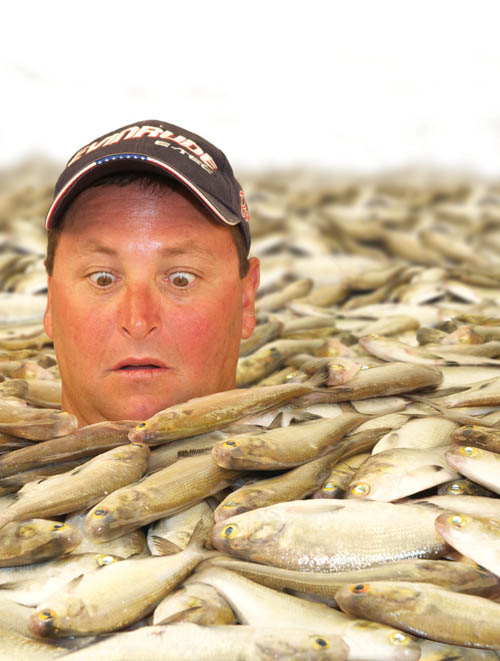
Editor’s note: For more in-depth articles about bass fishing, learn about a subscription to FLW Outdoors Magazine, where this article first appeared.
——————————————-
Two fall days. Two giant schools of shad. Two completely different outcomes.
A couple of members of the magazine staff and I watched the first shad school crash into our creek arm like a wave. The school was a swimming blanket of silver and gray covering the mouth of the arm, washing its way past the boat and blacking out the electronics. None of us had ever seen a school of shad so large – or so many surface explosions and diagonal lines on the electronics. Bass seemed as plentiful as the shad, and for an hour we caught them every cast by slow-reeling crankbaits, laughing as we argued who got the pliers next.
The second school surprised Cadiz, Ky., pro Ramie Colson Jr. and me on a main-lake flat. We were working the ledge at the edge of the flat when the water in front of us was transformed into a battleground. The surface of the water looked like it was under aerial assault, with frothy explosions of bass busting shad at the surface for hundreds of yards. We cast everything we could think of – spinnerbaits, topwaters, rattle baits and even the magic crankbait that had worked before. Thirty minutes later, the school had continued on down the ledge, the trail of surface eruptions visible for another 15 minutes. We were left with parting gifts of two bass and plenty of disappointment.
“I can’t believe with all those bass that we only could catch two,” I say, utterly defeated.
“I know,” Colson replies, shaking his head. “But it’s kind of hard to feed them artificials when they already have steak.”
Colson’s statement couldn’t be truer. If given the choice, a bass is going to eat a live shad over a crankbait almost every time, especially when the bass is surrounded by millions of live shad.
But if that’s the case, then why did we catch them so well in the first scenario?
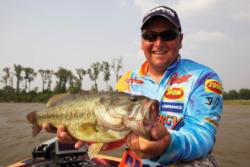
It’s a question that vexes almost every angler, both professional and amateur. It’s also a question with no definitive answer. We asked a few pros who have encountered the too-much-bait problem at one time or another for advice. Nothing is set in stone, but experimenting with the various approaches they suggest might help you turn a bad situation into some of the best fishing you’ve ever experienced.
Find the right lure
Ramie Colson Jr.
Colson is no stranger to the problem of having too much bait. He grew up near Kentucky and Barkley lakes and both reservoirs are loaded with shad. In the fall, once young-of-the-year threadfins have reached an attractive size for bass, it’s not uncommon to see schools of shad so thick and large that they resemble whales swimming beneath the surface. When it’s Colson’s boat they’re passing near, he starts thinking about the one lure that will fill up his livewell in a hurry.
“There is usually one lure that is the only lure they want,” he says. “We never figured out what that lure was that one day [mentioned at the beginning of this article], but when you do figure it out you can catch them every cast. You just have to wade through different lures to find it.”
That’s what happened during our magazine field trip. The school rolled into a creek, and bass were busting near the surface, suggesting that topwaters and spinnerbaits fished at the surface would draw strikes. They produced a couple bass, but it wasn’t until one of us tied on a ghost minnow Jackall MC/60 crankbait that we started catching fish consistently. Luckily, we all happened to have that particular lure, in both shallow- and medium-diving models, and in that color. So we all caught fish.
Here’s the kicker, though. After awhile, we started experimenting with different crankbaits to see if they would work. We tried different colors, diving depths and models. None of them caught fish with any consistency. But one of us always had on the MC/60, and that person never stopped catching fish.
It was owing to luck that we happened to have the right crankbait, but it illustrates Colson’s point that there is always one lure that will get the attention of the bass among the throngs of bait. And that lure can change as bass change their preference.
That same MC/60 that worked so well the first day on Kentucky Lake caught only one fish the second 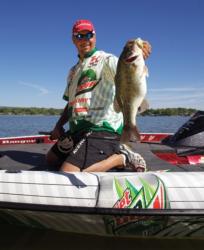
day on Lake Barkley with Colson. Could they not see it in the different colored water? Was it running too deep or shallow? Was I reeling it too slow? Who knows? What’s important is that Colson has had plenty of times when finding that one lure meant he caught fish nonstop. There were other times when not finding it resulted in little action.
Get their attention
Jason Christie and Shad Schenck
When Diet Mountain Dew pro Jason Christie of Park hill, Okla., first started fishing Grand Lake O’ the Cherokees, he quickly located dozens of pockets where every third cast snagged a shad. A slam-dunk area to fish, right?
“Twenty years later, and I have yet to catch fish from any of them with any consistency,” Christie says.
The only thing that has worked for Christie is the same thing that works for Waynetown, Ind., pro Shad Schenck: being different.
“Most of the time you want to match the hatch,” Schenck says. “[When there is too much bait] is the exception.”
Instead of throwing a small crankbait to imitate the thousands of small shad swimming around, either pro will experiment with offerings that stand out from the crowd. For Christie, a 5-inch YUM Money Minnow swimbait, Heddon Super Spook or a big jig swam through the area are his eye-catching 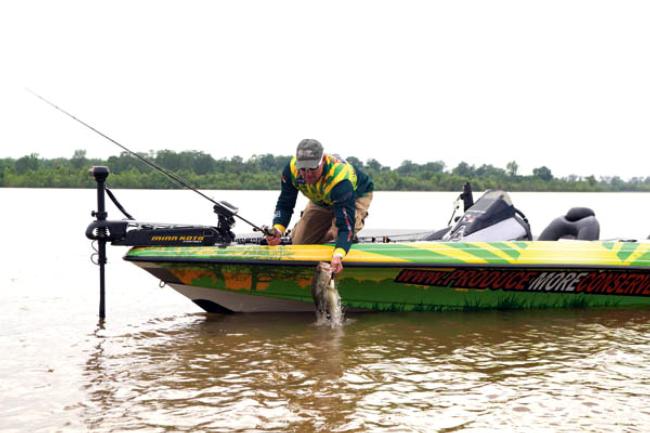 offerings. Similarly, Schenck ties on a spinnerbait with large blades or a 10-inch worm.
offerings. Similarly, Schenck ties on a spinnerbait with large blades or a 10-inch worm.
The other advantage of going big, loud and different with lure choice is that it often elicits larger bites, as large bass are less likely to expend a lot of energy chasing schools of small shad. They would rather eat a large meal that’s offset from the school.
Being different can also be accomplished with the retrieve. Christie will work the Super Spook as fast as he can across the surface or burn his swim jig to elicit reaction strikes. It can even get more extreme than that.
Prevacid pro Dan Morehead won a tournament in 1998 on Lake of the Ozarks by throwing a buzzbait on shore and reeling it into the water. Shad had accumulated en masse around chunk-rock banks, often in the shallowest water they could reach. Morehead held his boat as close to shore as possible and made nearly parallel casts that ended up on shore. Often, within a couple turns of the reel handle from the time the lure touched the water, a bass would eat the buzzbait.
Plenty of other pros were on a similar pattern, but their presentations weren’t as effective as Morehead’s. By bringing his buzzbait into the water from off the bank, Morehead was able to get his lure running on the surface the entire time it was in the water, as opposed to wasting a couple of feet of retrieve to get it up on the surface. Those 2 feet were critical to get the attention of bass already surrounded by what they wanted to eat.
Trigger or tempt
Clifford Pirch
When pro Clifford Pirch won the October 2009 FLW Series National Guard Western Division event on Clear Lake, he did it fishing offshore. However, his initial plan was to fish shallow because that’s where the bait was – a lot of bait.
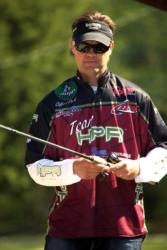
“Every dock post in 5 feet of water or less had thick schools of minnows around it,” says the Payson, Ariz., pro. “I’m not sure what kind of minnows they were, but they were about 2 1/2 inches long and they were everywhere. And the bass were right there with them.”
With so much bait, Pirch originally opted to go for a reaction bite, burning a lipless crankbait right through the schools of minnows. It worked, but not like he thought it would.
He caught some bass, but more often they would swirl on the lure or bump it as it went by. The bass would show their location, allowing Pirch to cast back to them with a drop-shot. The key then was to let the drop-shot sit as motionless as possible.
“I wanted to make the worm look like it was wounded or dying,” Pirch says. “When there is that much bait around, it’s not always an easy meal. The schools can be bunched really tight, making it hard for a bass to single out a meal, or the minnows can all flee, making a bass have to chase. By dead-sticking that drop-shot, I gave the bass an easy meal that it could just swim over to and eat.”
Obviously, this is not a search tactic. However, a jerkbait fulfills the same criteria, and it can cover more water.
Any of the early spring Walmart FLW Tour events on Table Rock or Beaver Lake the last three years provide an example. A universal complaint at their weigh-ins was that there was too much bait. And in all of them, a jerkbait dominated. The conditions were similar to what Pirch experienced under those California docks.
There were schools of shad everywhere, giving the bass plenty to eat. Better yet, the cold water was shocking and killing shad, allowing bass to swim around and munch on helpless shad easily instead of wasting energy trying to chase healthy shad within the schools. The anglers picked up on this and mimicked the dying shad with jerkbaits.
The pros employed long pauses between twitches to mimic distressed shad. It was simply too tempting for bass to resist, even with all the live shad swimming around them.